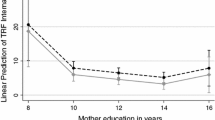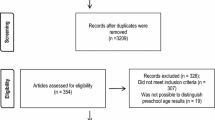Abstract
This study prospectively investigated developmental psychopathology pathway from the age of 7 to ages 14–16. The subjects (N = 1,857) were evaluated using the Korean version of the Child Behavior Checklist and reassessed using the Korean Youth Self Report. In path analyses, total problems, externalizing problems, and internalizing problems in childhood associated significantly with problems in adolescence. In particular, childhood externalizing problems associated with adolescent externalizing problems, for both genders. However, our results differ from those of previous studies in that internalizing problems showed a restrictive stability by gender and in that early externalizing problems correlated negatively with later internalizing problems for girls. In the syndrome scales analyses, we confirmed that some syndromes showed heterotypic pathways, despite the general continuity of the developmental psychopathology. The importance of Anxiety/Depression and Attention problems in childhood suggested that adolescent difficulties are a consequence of an accumulation of such risk factors.

Similar content being viewed by others
References
Achenbach, T. M. (1991a). Manual for the child behavior checklist 4–18 and 1991 profile. Burlington: University of Vermont Department of Psychiatry.
Achenbach, T. M. (1991b). Manual for the youth self report and 1991 profile. Burlington University of Vermont, Department of Psychiatry.
Achenbach, T. M., Howell, C. T., McConaughy, S. H., & Stanger, C. (1995). Six-year predictors of problems in a national sample: III. Transitions to young adult syndromes. Journal of the American Academy of Child and Adolescent Psychiatry, 34(5), 658–669.
Angold, A., Erkanli, A., Silberg, J., Eaves, L., & Costello, E. J. (2002). Depression scale scores in 8–17-year-olds: Effects of age and gender. Journal of Child Psychology and Psychiatry, 43(8), 1052–1063.
Angold, A., & Rutter, M. (1992). Effects of age and pubertal status on depression in a large clinical sample. Development and Psychopathology, 4, 5–28.
Ashford, J., Smit, F., van Lier, P. A., Cuijpers, P., & Koot, H. M. (2008). Early risk indicators of internalizing problems in late childhood: A 9-year longitudinal study. Journal of Child Psychology and Psychiatry, 49(7), 774–780.
Buchanan, A., Flouri, E., & Ten Brinke, J. (2002). Emotional and behavioural problems in childhood and distress in adult life: Risk and protective factors. Australian and New Zealand Journal of Psychiatry, 36(4), 521–527.
Cho, S., & Nam, M. (1994). Relationship between depression/anxiety and conduct disorder in children and adolescents. Journal of Korean Neuropsychiatric Association, 33(6), 1273–1284.
Choi, J., & Cho, S. C. (1990). Assessment of anxiety in children—reliability and validity of revised children’s manifest anxiety scale. Journal of Korean Neuropsychiatric Association, 29(3), 691–702.
Costello, E. J., Angold, A., & Keeler, G. P. (1999). Adolescent outcomes of childhood disorders: The consequences of severity and impairment. Journal of the American Academy of Child and Adolescent Psychiatry, 38(2), 121–128.
Costello, E. J., Mustillo, S., Erkanli, A., Keeler, G., & Angold, A. (2003). Prevalence and development of psychiatric disorders in childhood and adolescence. Archives of General Psychiatry, 60(8), 837–844.
Crick, N. R., & Zahn-Waxler, C. (2003). The development of psychopathology in females and males: Current progress and future challenges. Development and Psychopathology, 15(3), 719–742.
Essex, M. J., Kraemer, H. C., Armstrong, J. M., Boyce, W. T., Goldsmith, H. H., Klein, M. H., et al. (2006). Exploring risk factors for the emergence of children’s mental health problems. Archives of General Psychiatry, 63(11), 1246–1256.
Fergusson, D. M., Horwood, L. J., & Ridder, E. M. (2005). Show me the child at seven: The consequences of conduct problems in childhood for psychosocial functioning in adulthood. Journal of Child Psychology and Psychiatry, 46(8), 837–849.
Harrington, R., Fudge, H., Rutter, M., Pickles, A., & Hill, J. (1991). Adult outcomes of childhood and adolescent depression: II. Links with antisocial disorders. Journal of the American Academy of Child and Adolescent Psychiatry, 30(3), 434–439.
Hofstra, M. B., Van der Ende, J., & Verhulst, F. C. (2000). Continuity and change of psychopathology from childhood into adulthood: A 14-year follow-up study. Journal of the American Academy of Child and Adolescent Psychiatry, 39(7), 850–858.
Hofstra, M. B., van der Ende, J., & Verhulst, F. C. (2002). Child and adolescent problems predict DSM-IV disorders in adulthood: A 14-year follow-up of a Dutch epidemiological sample. Journal of the American Academy of Child and Adolescent Psychiatry, 41(2), 182–189.
Kim, S., & Lee, B. (2009). Patterns of delinquent behavior trajectory and their effect factors. Journal of Korean Child Studies, 30(5), 103–117.
Kim-Cohen, J., Caspi, A., Moffitt, T. E., Harrington, H., Milne, B. J., & Poulton, R. (2003). Prior juvenile diagnoses in adults with mental disorder: Developmental follow-back of a prospective-longitudinal cohort. Archives of General Psychiatry, 60(7), 709–717.
Maughan, B., & Kim-Cohen, J. (2005). Continuities between childhood and adult life. British Journal of Psychiatry, 187, 301–303.
Mesman, J., Bongers, I. L., & Koot, H. M. (2001). Preschool developmental pathways to preadolescent internalizing and externalizing problems. Journal of Child Psychology and Psychiatry, 42(5), 679–689.
Mesman, J., & Koot, H. M. (2000). Child-reported depression and anxiety in preadolescence: I. Associations with parent- and teacher-reported problems. Journal of the American Academy of Child and Adolescent Psychiatry, 39(11), 1371–1378.
Molina, B. S., Smith, B. H., & Pelham, W. E. (2001). Factor structure and criterion validity of secondary school teacher ratings of ADHD and ODD. Journal of Abnormal Child Psychology, 29(1), 71–82.
Oh, K., Ha, E., Lee, H., & Hong, K. (2001). K-YSR. Seoul, Korea: Chung Ang Aptitude Publishing Co.
Oh, K., Hong, K., Lee, H., & Ha, E. (1997). K-CBCL. Seoul, Korea: Chung Ang Aptitude Publishing Co.
Oh, K., & Lee, H. (1990). Empirically derived syndromes of Korean children and adolescents: Analyses of child behavior checklist data from clinic referred boys aged 4–5, 6–11. Korean Journal of Clinical Psychology, 9(1), 33–55.
Park, J. (2008). Factor analysis of children’s depression inventory—in a population of a general children in a small city in Korea. Journal of Korean Neuropsychiatric Association, 47(6), 555–560.
Pihlakoski, L., Sourander, A., Aromaa, M., Rautava, P., Helenius, H., & Sillanpaa, M. (2006). The continuity of psychopathology from early childhood to preadolescence: A prospective cohort study of 3–12-year-old children. European Child and Adolescent Psychiatry, 15(7), 409–417.
Pine, D. S., Cohen, E., Cohen, P., & Brook, J. S. (2000). Social phobia and the persistence of conduct problems. Journal of Child Psychology and Psychiatry, 41(5), 657–665.
Shin, M., Kim, H., & Kim, J. (2005). Depression of the adolescent reporting the symptoms of attention-deficit/hyperactivity disorder: Mediating effect of self-concept. The Korean Journal of Clinical Psychology, 24(4), 903–916.
Sourander, A., & Helstela, L. (2005). Childhood predictors of externalizing and internalizing problems in adolescence. A prospective follow-up study from age 8 to 16. European Child and Adolescent Psychiatry, 14(8), 415–423.
Sourander, A., Jensen, P., Davies, M., Niemela, S., Elonheimo, H., Ristkari, T., et al. (2007). Who is at greatest risk of adverse long-term outcomes? The Finnish from a boy to a man study. Journal of the American Academy of Child and Adolescent Psychiatry, 46(9), 1148–1161.
Stanger, C., MacDonald, V. V., McConaughy, S. H., & Achenbach, T. M. (1996). Predictors of cross-informant syndromes among children and youths referred for mental health services. Journal of Abnormal Child Psychology, 24(5), 597–614.
Tremblay, R. E., Pihl, R. O., Vitaro, F., & Dobkin, P. L. (1994). Predicting early onset of male antisocial behavior from preschool behavior. Archives of General Psychiatry, 51(9), 732–739.
Visser, J. H., van der Ende, J., Koot, H. M., & Verhulst, F. C. (1999). Continuity of psychopathology in youths referred to mental health services. Journal of the American Academy of Child and Adolescent Psychiatry, 38(12), 1560–1568.
Acknowledgments
This work was supported in part by a grant from the Ajou University Research Foundation.
Author information
Authors and Affiliations
Corresponding author
Rights and permissions
About this article
Cite this article
Shin, YM., Sung, MJ., Lim, KY. et al. The Pathway of Internalizing and Externalizing Problems from Childhood to Adolescence: A Prospective Study from Age 7 to 14–16 in Korea. Community Ment Health J 48, 384–391 (2012). https://doi.org/10.1007/s10597-011-9468-8
Received:
Accepted:
Published:
Issue Date:
DOI: https://doi.org/10.1007/s10597-011-9468-8




